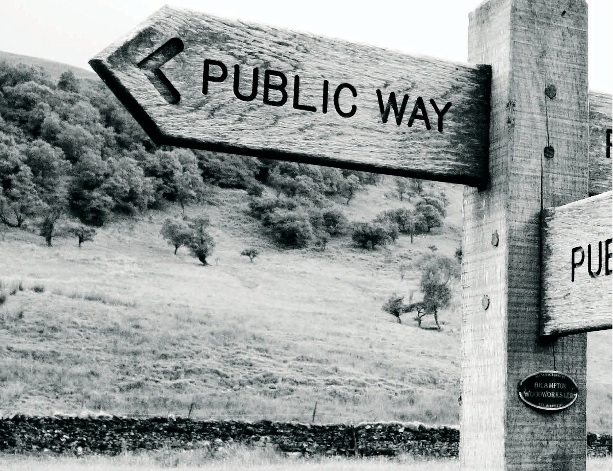Exciting access news took access campaigners by surprise yesterday. Here’s Cycling UK’s response – more information and reactions as we get it.
Welsh land shake-up most significant in over a decade
- Welsh Government proposals will allow cycling and horse riding on many footpaths
- Move welcomed by Cycling UK which says will benefit rural economy
The Welsh Government’s announcement today (Thursday, 4 April) has proposed changes to public access which will substantially change how people can enjoy the countryside and is hailed by Cycling UK as potentially being “the most significant changes to rights of way legislation since Scotland’s Land Reform Act in 2003”.
The proposals are wide ranging. They include measures to ensure dogs are kept on leads around livestock, give farmers more flexibility in managing their land and will grant horse riders and cyclists the ability to use many footpaths.
Currently in Wales, horse riders and cyclists are allowed to use only 20 per cent of the rights of way network. The Welsh Government proposals would significantly increase riding opportunities, but would not grant access to the entire footpath network. This is seen as a pragmatic move by Cycling UK, which recognise not all routes would be suitable for shared use.
Open access land, such as expanses of moorlands like Cadair Idris and the Berwyn mountains in North Wales and Natural Resources Wales’ forests, will also see certain restrictions lifted.
Cycling and horse riding, hang-gliding and para-gliding, along with swimming and canoeing on natural bodies of water will become possible in these areas. Organised games and camping will however still be largely prohibited without prior permission.
“These proposals, when implemented, could be the most significant changes to rights of way legislation since Scotland’s Land Reform Act in 2003,” said Duncan Dollimore, Cycling UK head of campaigns. “Through Cycling UK’s Trails for Wales campaign, over 12,000 people have written to the Welsh Government calling for change, and it’s a great day for Wales and lovers of the outdoors that they have listened.”
In the UK, only the Scottish Government has passed laws to improve access radically, with the Land Reform (Scotland) Act 2003. This law allows people the right to access and cross land for recreational and educational purposes, unless expressly forbidden to do so. Consequently local tourism has boomed, with cycle tourism estimated to generate between £236 and £358 million for the Scottish economy each year.
The Welsh Government proposed to open its rights of way up to allow more cycling in 2017. This was roundly welcomed by Cycling UK through its Trails for Wales campaign, and other campaigning organisations which all saw the need for a change in access policy.
There was a large amount of public support for these proposals, with 16,468 out of a total of 17,391 responses supporting change to access laws in response to the Government’s consultation “Taking Forward Wales’ Sustainable Management of Natural Resources” in September 2017.
Mr Dollimore said:
“Improving public access, particularly in the creation or restoration of connected routes is a public good. Farmers, visitors and local communities in Wales will all benefit – and today’s announcement from the Minister is the next important step to achieving this.”
Comments (8)
Leave Reply
Post Comment


Good news for cyclists and lets hope others too.
It will be interesting to see how they define which footpaths will be opened-up to cyclists and horse riders. I can’t imagine they’d proactively survey the entire network and then make decisions on a case-by-case basis, so I guess they’d have a starting point that is either ‘all’ or ‘none’ with a process to add or remove.
Obviously it would be preferable that it would be ‘all’ by default, with an exception-based process that gives landowners and others the ability to propose removal from scope. I would also hope that the process is time-limited to a period of just a few years.
If this happens it will be great news and ups the pressure on England to sort out its rights of way mess.
I think that the ‘riding on footpaths’ thing has been looked at in theory by some land managers. The biggest factor that I can see is on suitability of gates, rather than paths. You’d need to pick tracks that have gates and not stiles, as you’d ideally make the route open to horses AND bikes. There’s no lifting horses over a stile 🙂
England is too densely populated (and militant) to be an easy win for similar access. If they could adopt the ‘racing on bridleways’ suggestion though – that would make a huge difference to event organisers…
For the ” access to ‘all’ by default” calls – here in Pembrokeshire I’ve had various chats with people at the coast national park as to opening it / parts of it to cyclists in the past, and while in many respects this would be great (I’d love to – have you seen our coastal path?!!) I can understand the reluctance since so much of it is right on the edge of “certain death” cliffs.
I would imagine it’s in cases like this where a blanket “all paths are open – go for it!” approach could have dire consequences. Understandable in the scheme of things I guess…
@andyspaceman good news is that the Welsh Government is looking to make it a default position that cycling (and horse riding) is allowed, with the plan to remove access to unsuitable footpaths. Devil’s in the detail on how they manage that though…
Chipps, you say that, but there are areas of Scotland in the Borders that are just as densely populated as most of England.
Things like stiles could be dealt with by incremental changes as existing ones wear out and get replaced. Stiles are a pain in the arse for a lot of walkers too – try getting over one with a baby strapped to you.
Cycling UK have done a follow-up post that deals with some of the issues raised above: https://www.cyclinguk.org/article/trails-wales-what-happens-now?fbclid=IwAR0BPNsH-o4W6FR8ziwG7fOh9oT5K12tp1dFWwl0jLaPhcKehPgscpjl7qI